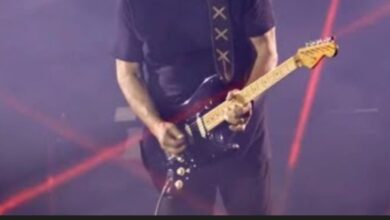Jimi Hendrix’s Woodstock Anthem: The Guitar Solo That Echoed the Chaos of War and Changed Music Forever
Jimi Hendrix’s rendition of the “Star-Spangled Banner” at Woodstock 1969 is one of the most iconic performances in rock history, blending artistry with political and social commentary. It was not just a musical performance but a raw, emotional expression of the turbulent times in America. Hendrix’s guitar, with its chaotic distortion and soaring notes, seemed to capture the essence of the Vietnam War, civil unrest, and the broader countercultural movement that was gaining momentum. His take on the National Anthem, played on the final morning of the three-day festival, stood out as a profound reflection of the nation’s collective emotions during that period.
At a time when the U.S. was deeply divided over the Vietnam War, Hendrix’s interpretation of the anthem seemed to echo the conflicting feelings of pride, sorrow, and protest. The distortion and feedback in his guitar reflected the chaos of the era, almost as if he was painting a sonic picture of the war and the social unrest back home. Many listeners heard not just a song, but the wailing cries of a nation in turmoil. The performance is widely viewed as a protest, though Hendrix himself maintained that he wasn’t overtly trying to make a political statement.
The notes of the anthem were recognizable but fragmented, interspersed with chaotic riffs and guitar effects that mimicked sounds of bombs and machine guns. It was as though Hendrix was channeling the horror of war through his instrument, making the performance a form of sonic storytelling. His control over the electric guitar allowed him to manipulate the anthem into something that was both familiar and alien, embodying both reverence for the ideals the anthem stood for and a critique of the reality many Americans were facing.
One of the reasons this performance is so often described as “the most musically creative” in history is due to Hendrix’s ability to convey deep emotion without words. Through his guitar, listeners could hear the sorrow, fear, and pain that many felt during the Vietnam War. The audience wasn’t just hearing music; they were experiencing a moment of reflection on the horrors of war. His innovative use of feedback and distortion allowed him to convey these emotions in a way that no other musician had done before.
The crowd at Woodstock, largely made up of young people disillusioned by the war and the political establishment, responded to Hendrix’s performance with awe. Many described feeling as though Hendrix had put into music what they were feeling but couldn’t express. The dissonance and unconventional interpretation of the anthem mirrored the disruption in their lives and in society at large. Hendrix’s version of the anthem wasn’t meant to unite, but to provoke thought and reflection, challenging the listeners’ perceptions of patriotism and war.
For Hendrix, a former paratrooper in the 101st Airborne, the performance had personal significance as well. While he expressed respect for the anthem and denied that it was intended as a protest, his connection to the military and the suffering he witnessed both at home and abroad gave his rendition an undeniable emotional weight. His decision to perform the anthem in such a radical way spoke volumes about the conflict between idealism and reality that defined the era.
What makes this performance even more remarkable is Hendrix’s technical mastery. His ability to coax such a wide range of sounds from his guitar, from the soft strains of the anthem’s opening to the violent feedback that mimicked the sounds of war, showed his unparalleled skill as a musician. He didn’t just play the anthem; he deconstructed it, making the guitar an extension of his own voice and emotions.
The performance wasn’t without controversy. Some viewed Hendrix’s rendition as disrespectful or unpatriotic, while others saw it as a brilliant artistic expression of dissent. In the decades since, it has been analyzed through countless lenses—musical, political, and cultural—each finding new layers of meaning in Hendrix’s interpretation. Despite the mixed reactions, one thing remains clear: the performance left an indelible mark on the cultural landscape.
As time has passed, Hendrix’s performance of the National Anthem has only grown in stature. It has become a defining moment not only in his career but in the history of rock music and American culture. It represents a fusion of art, emotion, and commentary that transcends the boundaries of traditional music. Even today, audiences continue to find new depths of meaning in his rendition, making it a timeless piece of art that resonates with each new generation.
In the end, Hendrix’s performance at Woodstock wasn’t just about the notes he played or the techniques he used. It was about the feelings he evoked, the conversations he started, and the way he forever changed how people perceive music’s power to comment on the world around them. His version of the National Anthem remains a haunting reminder of the struggles and hopes of a generation, and it continues to inspire reflection on the role of music in times of conflict and change.



